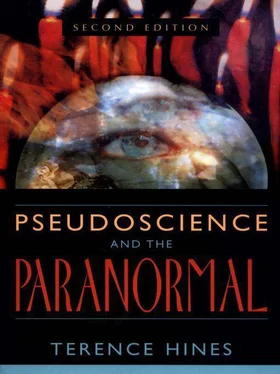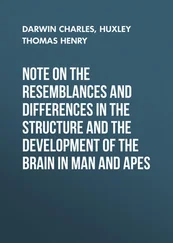The data on the lunar effect, then, shows overwhelmingly that the moon’s phases have no effect on human behavior. Why do so many people continue to believe that “moon madness” exists? A clue can be found in a study by Angus (1973). This study revealed that nurses who believed in the reality of the moon’s influence on behavior made more notes of patients’ “unusual” behavior when the moon was full than did nurses who did not believe the moon influenced behavior. Nurses who believed that the moon influenced behavior knew when the moon was full and at those times expected, looked for, and, not surprisingly, found more noteworthy behavior. Other nurses, who did not believe that the moon influences behavior, did not search for incidents to validate their belief.
According to biorhythm theory, three fixed and immutable rhythms, set at the moment of birth, cycle throughout human life and influence almost every facet of human behavior. There is a twenty-three-day physical rhythm, a twenty-eight-day emotional rhythm, and a thirty-three-day intellectual rhythm. The rhythms are usually depicted as changing over time in a sinusoidal fashion. Days when a given rhythm is above the baseline are referred to as “up” days and are supposed to be good days for engaging in behaviors related to the rhythm in question (Gittelson 1982). On the other hand, days when a particular rhythm is below baseline are “down” days and are thought to be poor days for engaging in behavior related to the rhythm in question. For example, athletic performance would be expected to be better on days when the physical rhythm is above baseline and poorer on days when that rhythm is below baseline. Similarly, scores on examinations should, according to the theory, be higher on intellectual “up” days than on days when the intellectual rhythm is below baseline.
There is another aspect to biorhythm theory. This concerns the critical day , a day on which one of the rhythms is changing from the up to the down phase, or vice versa. These days, according to the theory, represent “our weakest and most vulnerable moments” and are when “we can expect ourselves to be in the most danger” since “at these points the rhythms that guide our lives become unstable” (Gittelson 1982, p. 15). The worst of all possible days is the much-dreaded triple critical day , when all three rhythms are changing phase. On such days, biorhythmists will tell you, you should stay in bed. Critical days (including double and triple critical days) make up only a little more than 20 percent of all days.
The basics of biorhythm theory were developed around the turn of the century by Viennese physician Wilhelm Fliess, a friend of Sigmund Freud. By any standards, Fliess was a world-class crackpot. He believed that all humans were basically bisexual; that being left-handed meant that the other sex’s characteristics determined, in large part, one’s personality; and that the sexual organs were represented on certain areas of the membranes in the nose. Fliess’s contribution to biorhythm theory was to invent the twenty-three-and twenty-eight-day cycles that, in line with his theory of bisexuality, he termed the “male” and “female” cycles. The thirty-three-day intellectual cycle was invented in the 1930s by Alfred Teltscher, an Austrian engineer (Wernli 1961; Thommen 1973). Martin Gardner (1966) has described the history of biorhythm theory in detail.
On the face of it, biorhythm theory is unlikely to be true. It requires an extremely precise type of biological timekeeping that does not exist. While it is certainly true that there are many biological rhythms—as distinct from “biorhythms”—known to affect human, animal, and even plant behavior (Moore-Ede, Sulzman, and Fuller 1982), these rhythms all have a feature strikingly absent in the alleged biorhythms: variability. Real biological rhythms are variable; their period changes over time. Even the best-known human biological rhythm, the female menstrual cycle, varies greatly from one female to another and from one cycle to another within the same female (Matsumoto, Nogami, and Ohkuri 1962). Further, the menstrual cycle has a very small effect on cognitive abilities and skilled performance (Sommer 1973). Unlike known biological rhythms, however, biorhythms are said to be absolutely unvarying throughout a person’s life. Changes in health, periods of illness, crisis, activity level, work schedule, and so forth, are said not to influence biorhythms.
It is largely this unvarying nature of the alleged biorhythms that makes them so easy to reckon. To calculate an individual’s position on any of the three biorhythms on a given date, all one has to know is the person’s birth date and the date for which the calculation is to be made. One then figures out how many days the person has lived until the day in question; that number is divided by twenty-three, twenty-eight, or thirty-three, depending on which biorhythm one is interested in. The remainder gives the person’s position in the biorhythm cycle on the day in question.
The evidence put forth by biorhythm proponents for the existence of these rhythms offers some classic examples of pseudoscientific thinking. The commonest ploy is to present lists of terrible things (like dying) that happened to people when they were on the down side of one or more of the rhythms. Airline crashes are favored by biorhythm proponents, who take joy revealing that the pilot, copilot, navigator, or a flight attendant was on a critical day of one or more of the three rhythms, or low on one or more of the three rhythms, the day the plane crashed. Of course, there have been a fair number of plane crashes and other disasters over the past century, so it’s not hard to find someone somehow associated with the disaster who was having a biorhythmically down or critical day at the time of the disaster. Similarly, lists of wonderful things (pitching a no-hitter, winning a boxing match, and so forth) that have happened to people when they were on the up phase of one or more of their biorhythms are presented as further proof of the validity of the theory.
Such lists are highly selective reporting and prove nothing. If one believed that, for example, accidents and disasters were more likely to occur on odd-numbered Thursdays that fell on even-numbered dates in years that end in odd numbers, one could probably come up with quite a list of accidents “proving” that danger lurks on such days. In fact, two minutes of looking through the World Almanac turned up two such accidents: The airship Hindenburg crashed on Thursday, May 6, 1937. May 6 was the first Thursday that month. On June 18, 1953, a U.S. Air Force C124 crashed near Tokyo, killing 129. June 18 was the third Thursday that month.
Further examination of the dates of disasters reveals many that took place on days other than Thursday, let alone a Thursday with the special characteristics noted above. But if one were writing a book to convince people that certain types of Thursdays were dangerous, or trying to sell a consulting service based on that premise, one certainly wouldn’t mention all the accidents that took place when the theory predicts they shouldn’t have. Similarly, you’ll never read in books written by biorhythm proponents about the thousands of events, good and bad, that took place when biorhythm theory predicted they shouldn’t. Many of these promoters have financial stakes in the theory’s validity. For example, Bernard Gittelson, author of the most popular book on biorhythm theory, first published in 1975, ran a biorhythm computer and consulting service in which he advised companies on how to schedule their employees according to their biorhythms. Another biorhythm author, Vincent Mallardi (1978), also ran a biorhythm consulting business.
Читать дальше












